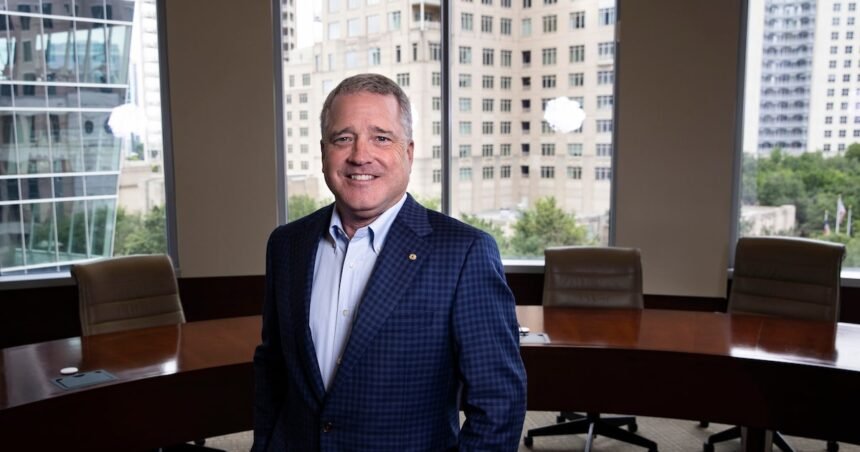Texas Capital Bancshares has managed to put together a string of wins in an economy that epitomizes the word unpredictable.
Overall, regional banks are facing multiple competitive headwinds, but the Dallas-based bank has managed to buck the trend — given ballast by a North Texas economy that’s outperforming most other regions around the country.
Although it retraced some of its move up to a 52-week high near $95 per share, the firm’s resurgent stock is still up over 30% over the last year.
The second quarter was a victory lap of sorts for Texas Capital, which wowed investors with its healthy balance sheet and high double-digit growth in both net income and earnings per share.
Meanwhile, its return on average assets, a key indicator of bank profitability, is within striking distance of 1%, the rough industry average for FDIC-insured institutions.
Considering trends like high interest rates and remote work that have turned the commercial real estate sector into something resembling The Hunger Games, that’s an accomplishment.
“A good quarter implies that it’s one and done. There’s a… dramatic structural change to the earnings power of the firm created over the last four years,” Rob Holmes, Texas Capital’s chairman, president and CEO, told The Dallas Morning News in a wide-ranging interview in the bank’s offices on McKinney Avenue in Uptown Dallas.
While not quite having a “fortress balance sheet” — a term used in the vernacular to describe bulge-bracket firms like JPMorgan Chase, Bank of America and others — Texas Capital is adding to its head count and building out new offerings, plus its securities arm is planning expansions in Los Angeles and Chicago.
In fact, the bank has done “an extraordinary amount of hiring for the last four years. About 90% of the people at this firm are new,” Holmes said, explaining that as Texas Capital has grown, it’s outperformed the bigger players in the industry in terms of retaining new hires.
In other words, Texas Capital doesn’t have a poaching or loyalty problem — the same of which can’t be said for certain marquee Wall Street firms.
“So there’s a lot of [recent graduates] that want to come to Texas and want to come to a platform like this,” Holmes tells The News. “We have two and a half times the number of front-line bankers that we had when we started.”
Deals a luxury, not a ‘necessity’
Consolidation, the rise of financial technology and nonbanking institutions have contributed to a dwindling number of FDIC-insured banks that play a role in everyday transactions.
With indexes near record highs and market sentiment improving, some banks have taken to mergers, which recently hit their highest levels since December 2021 in terms of monthly aggregate deal value, according to S&P Global data.
In July, Veritex Holdings — another Dallas-based bank — agreed to a buyout from Huntington Bancshares, a Midwest regional powerhouse with ambitions to deepen its Texas footprint.
Holmes, however, suggested Texas Capital had no immediate interest in joining the fray.
Texas Capital Bank headquarters are located on McKinney Avenue in Uptown Dallas, as seen on Sept. 20, 2021.
Liesbeth Powers / Special Contributor
“Up until now, we didn’t feel like we had earned the right to do M&A because of our financial performance,” he said in response to a question from The News about whether Texas Capital would consider a deal of its own.
“And now with our financial performance and continued strength, capital, liquidity… we have earned the right to do M&A, and while it is an option for us to do, it’s not necessary to do so,” Holmes added.
“We feel like the transformation is actually better [than] an M&A deal, and now we can scale that in a very advantageous way,” he added.
The booming Dallas-Fort Worth economy, with its emphasis on big real estate deals, tells much of the story about Texas Capital’s financials.
The bank’s clientele consists mainly of business and commercial borrowers, plus a growing coterie of high-net-worth individuals that the firm sees as an integral part of its future.
One thing that bulge brackets and regional institutions alike have to be mindful of is interest rate risk. Slowing growth and sticky inflation have stoked a debate about whether the Federal Reserve needs to cut interest rates to support softening labor markets and economic activity.
While acknowledging that “the cost of capital is real, and that rates were artificially low for a very long time,” Holmes said he feels that rates at current levels aren’t restrictive enough to warrant a cut.
“I’ve also been on record for like, two years saying I did not think the Fed was going to cut, so I’ve been right for a long time,” he said.
“And I think what people need to remember is when the Fed does cut, it’s because something’s going wrong, and I’m not sure why anybody wants anything to go wrong,” the CEO added.
“The economy’s rolling along just fine about second gear, and whether you like or dislike the Big, Beautiful Bill, it’s a growth bill. So I think it’ll help the economy for sure,” Holmes added.











